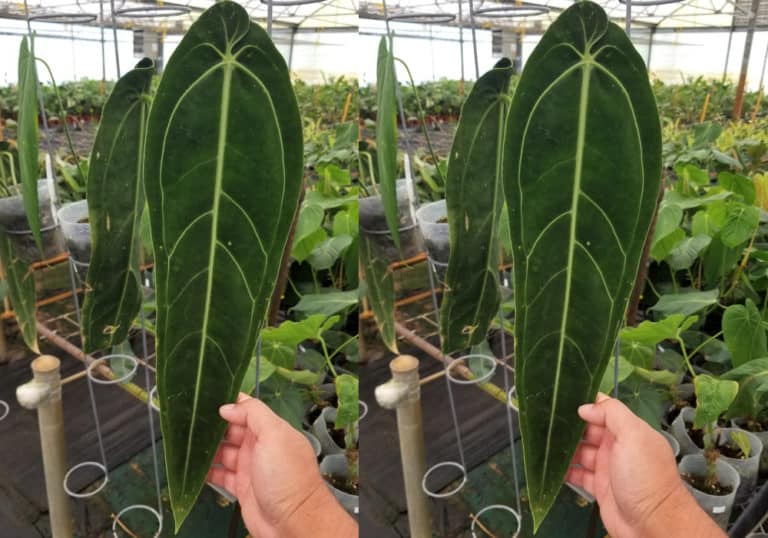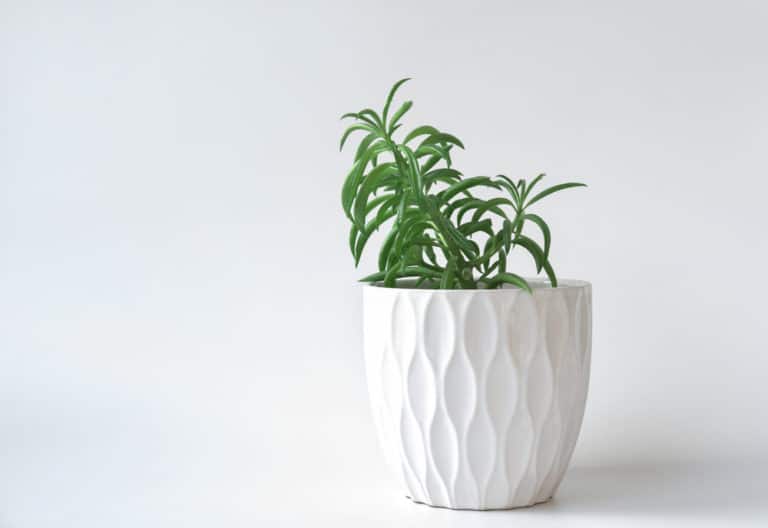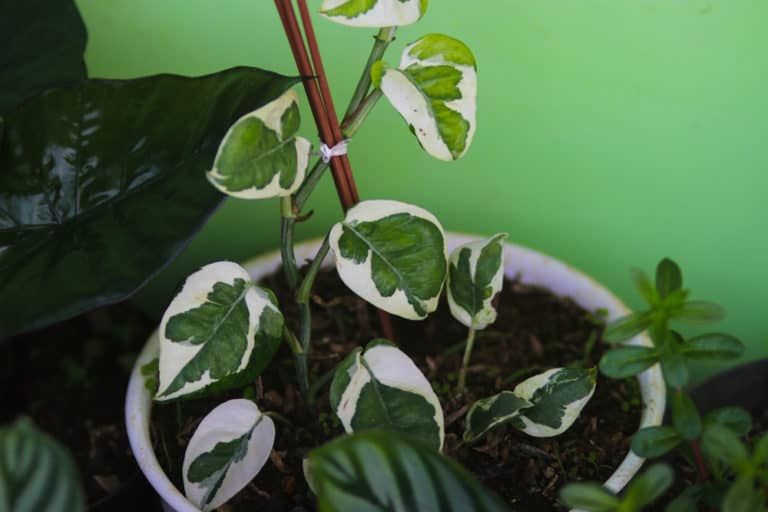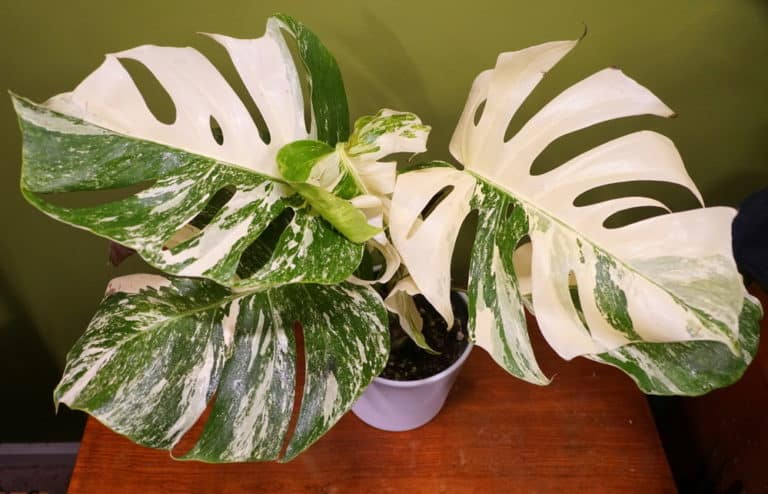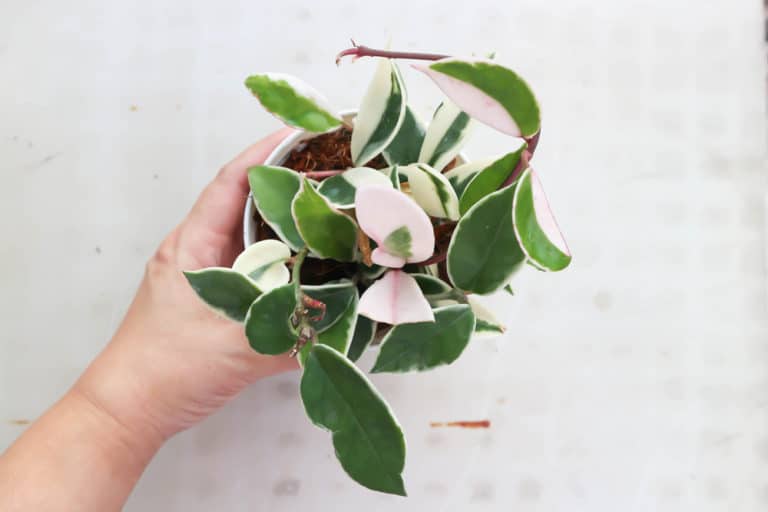Asparagus Plumosus ‘Plumosa Fern’ Care Guide (2024)
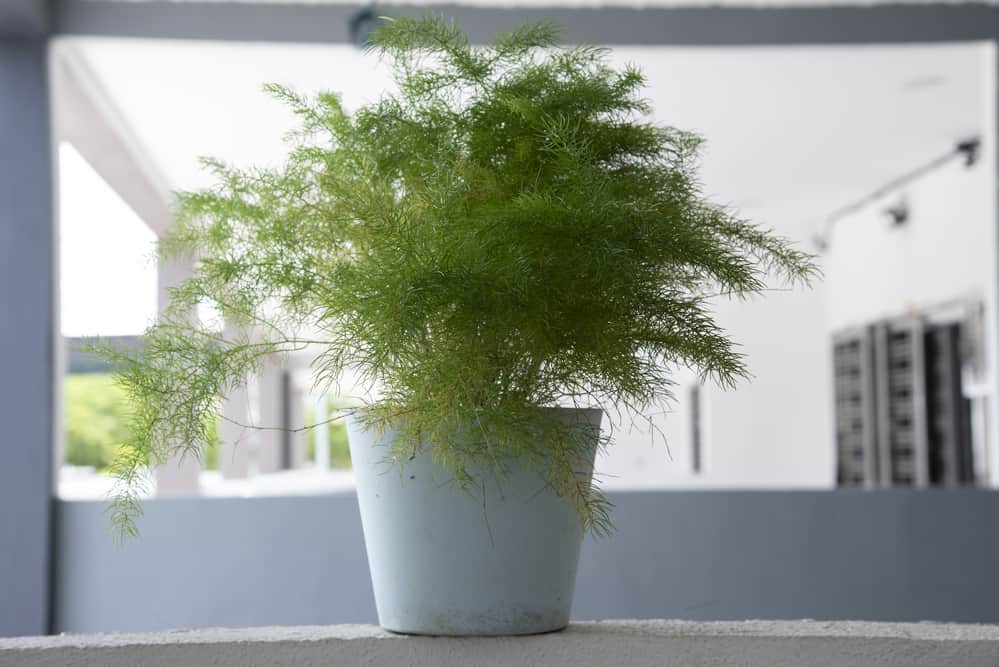
We call this lacy plant plumosa fern, but in actual fact Asparagus plumosus is not a member of the fern family at all!
As you might have guessed from its scientific name, it’s actually a member of the Asparagus family.
Since it was first discovered in the mid-1800s, it’s become a favorite houseplant for its attractive appearance and ease of care.
| Scientific Name | Asparagus plumosus |
| Common Name | Plumosa Fern, Asparagus Fern, Lace Fern |
| Light | Bright indirect sunlight |
| Watering | Water if the top inch of soil is dry |
| Temperature | 70 to 90ºF (21 to 32ºC) |
| Hardiness Zone | 9 to 12 |
| Humidity | 70% |
| Soil Type | Rich, quick-draining, loamy |
| Soil pH | 6.5 to 6.8 (mildly acidic) |
| Fertilizing | A balanced feed once a month in spring and summer |
| Repotting | Every 2 years |
| Pruning | Beginning of the growing season |
| Propagation | Division |
| Toxicity | Toxic to humans and pets |
| Mature Size | 2 feet high with 5-foot trailing stems |
| Bloom Time | Spring through fall |
What’s Unique About Plumosa Fern?
The plumosa fern plant is native to south-east Africa, where it grows in tropical and subtropical rainforests.
Plumosa fern plants are grown not just as easy-care houseplants, but the foliage is a staple of the cut-flower industry as a bouquet filler.
As long as you keep it well watered, growing plumosa fern is easy, making it a great choice for beginner gardeners.
Its lacy, delicate fronds combine beautifully with large-leafed tropical houseplants to create an indoor garden with varied textures.
As an added bonus, Asparagus fern plumosa is rated as one of the top 5 air purifier plants, proven to scrub benzene, octane, toluene and alpha-Pinene from the indoor atmosphere.
Plumosa Fern Care
The plumosa plant originates in the rainforests of south-east Africa.
Plumosa fern plant care needs to take into account the hot and humid conditions in which this tropical plant evolved.
For your Asparagus plumosus care, concentrate on providing it with consistent soil moisture, heat, humidity, and plenty of bright, indirect light.
Light
One of the reasons the plumosa fern is such a popular houseplant is because it is naturally well-adapted to indoor light levels.
In its native subtropical rainforest environment, the plumosa fern grows on the forest floor, far below the tree canopy which filters the bright sun overhead.
As a result, the plumosa fern light requirements are for bright but indirect light, or between 10,000 to 20,000 lux.
You should be able to accommodate Asparagus plumosus light needs in almost any location. In an east or north-facing room, put it right in a window.
If you have a south or west exposure, however, find a spot for it out of the full sun, which will damage its delicate leaves.
Watering
In its native region, plumosa fern is used to regular, moderate rainfall every few days in spring and summer.
In winter, however, conditions are much drier, with maybe only a day or so of rain a month.
Follow this same seasonal variation for your plumosa fern watering.
In spring and summer, water Asparagus plumosus whenever the top inch of the soil has dried out.
In winter, its watering needs will drop off, and you can let the soil almost dry out before giving it a good soaking.
Rainwater is the best for your plant, but if you must use tap water, let it sit overnight so that chemicals like fluoride and chlorine can dissipate.
Temperature
Temperatures in Malawi, in the heart of plumosa fern’s native range, go from 75 to 90ºF (24 to 33ºC) during the day, with monthly nighttime low averages between 60 to 70ºF (15 to 21ºC).
You can usually easily achieve the low end of the recommended plumosa fern temperature range of 70 to 90ºF (21 to 32ºC) in your home.
To provide a higher temperature for Asparagus plumosus, take your plant outdoors to enjoy the hot summer weather.
Just remember that it has little temperature tolerance below 60ºF (15ºC), and will need to be brought in as fall approaches.
As well, it has no frost hardiness, so never expose it to freezing temperatures.
Humidity
The humidity level in south-east Africa can be as high as 80% in summer, although it may drop to a more manageable 50 or 60% in winter.
The ideal humidity for Asparagus plumosus is around 70%, although you may be able to get away with a humidity level as low as 50%.
However, if you start to notice brown tips on your plumosa fern’s leaves, it’s time to get more serious about meeting your plumosa fern humidity requirements.
Misting the foliage will help, but it can get labor-intensive to do that on a daily basis.
You can group all your humidity-loving plants together and let them create their own microclimate simply through proximity.
A system of pebble trays, or best of all, a humidifier, will really give them the extra humidity they need.
Soil
The soil in a rainforest is loose and spongy, and full of organic matter. It never stays soaking wet as the water drains through it easily, but it always retains a certain amount of moisture.
You want your plumosa fern soil to do the same thing.
The best pH level for Asparagus plumosus is 6.5 to 6.8 (mildly acidic).
You can make your own soil for Asparagus plumosus using a standard indoor potting soil mix.
Adding in some perlite or peat moss will improve its draining abilities, and a handful of well-rotted compost will give your plumosa fern a nutrient boost.
Fertilizer
Using fertilizer for Asparagus plumosus will help it maintain its lovely foliage year-round.
The best way to apply plumosa fern fertilizer is to add a good amount of compost when repotting.
However, you can also use a liquid or granular fertilizer with a balanced fertilizer ratio of 10-101-10.
For the liquid fertilizer, dilute it to half the recommended strength and pour it evenly over the soil surface once a month.
If you use a slow-release granular fertilizer, every 6 weeks mix it into the top few inches of the soil towards the outer edges of the pot.
Do not fertilize at all in fall and winter.
Potting & Repotting
Plumosa fern repotting only needs to be done every 2 years unless you notice that it is getting rootbound.
It will be easy to tell; if it’s in a plastic pot, you may see the sides getting pushed out by the roots inside, or roots growing out of the drainage holes.
When repotting Asparagus plumosus, only move up one pot size, as too big a pot will have too much soil for the volume of roots.
It’s best to use a plastic or glazed clay pot, as a terra cotta pot won’t conserve enough soil moisture.
Always use fresh potting soil to avoid a build-up of disease.
Pruning
Plumosa fern pruning should be done annually in early spring to maintain an attractive shape, as it can get scraggly if left to its own devices.
The plumosa fern will respond well to a hard pruning, so don’t hesitate to cut stems back right to the soil level. You can even chop off all of them to give it a fresh start.
You can also trim just the stem tips to encourage more bushy growth, or chop the stems off at whatever length you prefer.
When cutting Asparagus plumosus it’s a good idea to wear sturdy gloves, as mature plants develop sharp thorns.
Propagation
The easiest method of Plumosa fern propagation is by division.
To propagate Asparagus plumosus, remove the root ball from its pot, and clean off as much of the soil on the roots as possible.
Start by trying to pull apart the tubers, which will probably be twisted together, especially if it’s very rootbound.
If you can’t do that, simply take a sharp knife and cut through the root ball to divide it into several chunks, each with some stems attached.
Then just pot each chunk up in its own pot, and voila! You’ve got two or more plumosa fern plants where previously you just had one.
Common Problems of Plumosa Fern
One of the reasons that this plant is so popular is because there are not many plumosa fern problems.
If you take care to give it the conditions it needs to thrive, you won’t have to worry about
problems with Asparagus plumosus.
As long as the leaves look good, everything is probably going well.
Pests
Of course, no houseplant is completely impervious to bugs, and the Asparagus plumosus is no exception.
However, if you spray the foliage with an insecticidal soap or neem oil solution every few weeks, you should be able to keep most plumosa fern pests away.
If they do turn up, you should be able to eliminate them if you catch them early.
Mealy bugs will gather together in white fuzzy clumps, and can be wiped off with a cotton ball soaked in rubbing alcohol.
Scale look like brown bumps rather than bugs. You can scrape them off gently.
Spider mites will leave their sticky webs as signs of their presence. Take your plumosa fern into the shower and hose it down.
Diseases
The most common plumosa fern diseases are bacterial or fungal infections that flourish when the soil is too wet.
If your Asparagus plumosus develops one of them, you should act quickly to prevent it spreading.
Root rot will turn the leaves yellow and the stalks red and soft. The roots themselves go black with a foul odor.
Crown rot also affects the stems, but they will look dry and dead, not mushy.
The first thing you should do is move the diseased plant away from the rest of your indoor garden.
To treat both of these infections, cut off all affected parts and replant your plumosa fern in fresh soil in a disinfected pot.
Growing Problems
General growing problems are also few and far between with this easygoing tropical plant.
Just tweak its growing conditions and your sick plant should recover.
Leaves turning yellow and dropping off may mean that your plumosa fern is not getting enough light. Move it into a brighter spot
On the other hand, bleached, pale green leaves indicate that it’s getting too much light, so you need to find a location out of the full sun.
If your plumosa fern leaves are getting brown tips, you need to up its humidity levels. If you have room in your bathroom, that’s a perfect solution.
Toxicity of Plumosa Fern
Asparagus plumosus is toxic to humans and pets, although it is a milder toxin.
Its toxicity is caused by the sapogenins that are found in all parts of the plant, but especially in the berries that follow after flowering.
It’s best to take precautions when growing the plumosa fern around children or animals.
For Humans
The plumosa fern is mildly toxic to humans, and could cause some discomfort.
It is recommended that you wear gloves when handling the plant to prevent the sap from getting on your skin, as even rubbing against the foliage may cause contact dermatitis.
Children may be at more risk because with their insatiable curiosity they might get too close to your plumosa fern.
They’re unlikely to try eating the ferny foliage, but if they ate the highly toxic berries that could cause some gastrointestinal distress, including vomiting and diarrhea.
However, it is not likely to proceed beyond that, so just manage the symptoms.
For Pets
Your pets can have adverse reactions from touching or eating plumosa fern foliage or berries.
If your cat or dog brushes up against a plumosa fern, it could develop blisters and a rash.
Ingesting the foliage or berries can cause intestinal pain, vomiting, and diarrhea.
You may be able to manage these symptoms at home, but depending on the weight of your cat or dog, it may become dehydrated and require veterinary care.
It’s best to find a place to grow your plumosa fern where it will be out of reach, such as a high ledge or a hanging basket.
Plumosa Fern Appearance
No matter what variety you grow, the plumosa fern appearance adds a soft texture to your garden tapestry.
The asparagus foxtail fern has long stems with its leaves arranged in a bushy manner that do, in fact, resemble a fox’s tail.
The Ming fern has more of a pom pom effect.
Foliage
The foliage of plumosa fern consists of long, soft fronds covered in soft, tiny leaves similar to fir needles. They are a popular addition to bouquets as a green filler.
The leaves grow in abundance on small lateral branches off of a main stem. Each branch is progressively shorter from the base to the tip of the stem, forming a triangular shape.
Each leaf is very narrow and short, and they are a bright lime green.
The stems develop very sharp thorns as they mature, which cause skin irritation, so it’s best to wear protective gloves when handling the foliage.
Flowering
Plumosa fern flowering occurs in spring through fall, during its active growing season.
Potted plants grown indoors are unlikely to bloom, but plumosa fern plants grown outdoors in tropical zones will probably flower.
You will see tiny white 2 or 3 petalled flowers blooming at the ends of the lateral branches for a dainty effect. They are fragrant, although reports are mixed as to the strength.
The flowers are followed by bright red berries that are toxic to mammals, although birds will eat them and spread the seeds as a result. This has contributed to its spread as a noxious weed in many areas.
Size and Growth
When grown indoors as a potted plant, the mature size of plumosa fern is about 2 feet tall with 5 feet of trailing stems.
Outdoors, they can climb 10 to 20 feet with a 3 foot spread. It has a rapid growth rate.
Growing plumosa fern outdoors must be undertaken with great caution. It has become an invasive plant in tropical and subtropical zones in places such as Australia, Hawaii, Cuba, New Zealand, and Florida.
Even when grown in containers outdoors, the seeds are spread far and wide by birds eating its berries.
It’s best to restrict it to growing indoors, even in tropical climates.
Plumosa Fern Fragrance
The foliage of the plumosa fern has no scent, and there doesn’t seem to be a clear agreement on what an Asparagus plumosus flower smells like.
One source says that the plumosa fern fragrance is “intoxicating like a tropical drink”, while another describes it as “buttered popcorn”.
Still others say it’s mild, or that there’s no fragrance to the flowers at all.
On the whole, the chances that you’ll smell anything are low if you’re growing your plumosa fern inside, as it very rarely blooms indoors.
However, it is considered one of the top five air purifying plants that you can grow, so it will vastly improve the quality of your home’s environment.
Suggested Uses for Plumosa Fern
When planning how to display your plumosa fern indoors, take your cue from the florist industry, which has used its lacy fronds for over a century in bouquets.
You can certainly showcase it on its own in a hanging basket or set it atop a high pedestal to let its stems trail down.
However, you can also incorporate it in a larger collection of plants, where its delicate foliage will contrast beautifully with large-leafed philodendrons or pothos.
When selecting which room in your home for your plumosa fern, consider your bedroom, so that its air-purifying benefits can help you get a good night’s sleep.
It would also love to hang out in your bathroom with its added humidity.
FAQ
What is plumosa fern?
The plumosa fern, or Asparagus plumosus, is a climbing or spreading evergreen perennial native to the rainforests of south-east Africa. It is grown as a houseplant.
How to identify plumosa fern?
The plumosa fern has short, narrow leaves that are similar to pine needles, growing on both upright and trailing stems. They are a bright green color.
How to care for plumosa fern?
The plumosa fern is a tropical native that should be kept in bright, indirect light in a warm and humid location, with frequent watering and regular light fertilization.
How to grow plumosa fern indoors?
The plumosa fern can be grown indoors as a potted plant in a warm, bright spot but kept out of the full sun, with consistently moist soil and high humidity.
How to grow plumosa fern outdoors?
It is not recommended to grow the plumosa fern in a tropical zone, as it is highly invasive and even a container-grown plant can end up spreading its seeds.
How fast does plumosa fern grow?
The plumosa fern has a fast growth rate, and will grow to its full size indoors within a few years. It will grow back after being hard pruned.
How tall does plumosa fern grow?
The plumosa fern will reach a height of 1 or 2 feet tall, but can also grow trailing stems up to 5 feet or so in length.
How to make plumosa fern grow faster?
The plumosa fern will grow faster when it gets the optimum conditions of moist but not wet soil, bright light but no direct sun, and a warm, humid environment.
How to stake plumosa fern?
The plumosa fern will climb if given a support such as a trellis or pole, but is usually grown as a trailing plant in a hanging basket or on a high ledge.
How to pot plumosa fern?
The plumosa fern should be grown in loose, rich soil with lots of organic matter, in a plastic or glazed pot with good drainage holes.
How to revive plumosa fern?
If it’s become leggy and scraggly, every 3 years or so the plumosa fern can be cut back right to the soil level to give it a fresh start.
Why is my plumosa fern dying?
Your plumosa fern may have root rot from being kept in consistently wet, rather than damp, soil. Remove and discard all the affected parts and replant in fresh soil.
Why is my plumosa fern drooping?
If your plumosa fern’s stems and leaves are drooping, it’s probably a sign that it needs more water. Give it a good soaking in a pail of tepid water.
How cold can plumosa fern tolerate?
The plumosa fern grows best at normal household temperatures, or in a hot tropical climate, but it will not tolerate temperatures below 60ºF (15ºC) for long, and frost will kill it.
How to get rid of pests on plumosa fern?
The plumosa fern is not susceptible to many pests, and you can deter the others with regular sprays of insecticidal soap or neem oil.
Is plumosa fern toxic to cats?
Yes, the plumosa fern is toxic to cats. If your cat starts vomiting or has diarrhea, it may need veterinary care to prevent serious dehydration.
Is plumosa fern toxic to dogs?
Yes, the plumosa fern is toxic to dogs. If your dog has eaten foliage or berries, and has severe vomiting or diarrhea, take it to the veterinarian.
Is plumosa fern toxic to children?
Yes, the plumosa fern is toxic to children. It’s rarely serious enough for medical attention, so you can usually manage the symptoms of gastrointestinal distress at home.
Is plumosa fern toxic to humans?
Yes, the plumosa fern is toxic to humans. You can develop contact dermatitis after exposure to the sap or foliage, so always wear protective covering when handling it.
Does plumosa fern have a scent?
The plumosa fern’s foliage has no scent, and there is no clear agreement on whether the rare flowers have a scent, or if they do, what it smells like.

